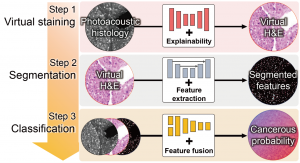Beyond Conventional Pathology, Label-free Histology Meets AI
GA, UNITED STATES, September 4, 2024 /EINPresswire.com/ -- POSTECH team develops deep-learning powered label-free photoacoustic histology for virtual staining, segmentation, and classification of human liver cancers.
A collaborative research team led by POSTECH Professor Chulhong Kim and Professor Chan Kwon Jung of Seoul St. Mary’s Hospital, Catholic University of Korea, has developed an artificial intelligence (AI) system to analyze the label-free photoacoustic histological images of human liver cancer tissues . Their research was recently published in “Light: Science and Applications,” an international journal of optics and photonics.
Histology is essential for diagnosing diseases and developing appropriate treatment plans. Typically, examining removed tissue under a microscope requires staining, which involves additional labor and cost due to the use of chemicals. Photoacoustic histology (PAH) technology has been developed to mitigate these issues. PAH generates images by detecting sound (ultrasound) signals produced by biomolecules when illuminated with light (laser), thus eliminating the need for staining and labeling. However, PAH was initially unfamiliar to pathologists, complicating interpretation and diagnosis, and resulting in relatively low accuracy.
In this study (https://doi.org/10.1038/s41377-024-01554-7), the researchers integrated PAH with cutting-edge deep learning models capable of virtual staining, segmentation, and classification of human tissue images.
Initially, the "virtual staining step" transforms black-and-white, unlabeled images—containing cell nuclei and cytoplasm—into images that mimic stained samples. This step is designed to produce images similar to actual stained samples while preserving tissue structures, and uses explainable deep learning methods to increase the reliability of the virtual staining results.
Next, during the “segmentation” phase, the unlabeled image and the virtual staining data are used to segment features of the sample such as cell area, cell count, and intercellular distances. Finally, in the “classification” phase, the model uses the unlabeled image, virtual staining image, and segmentation data to classify whether the tissues are cancerous or not.
The researchers applied their deep learning model to the PAH images of human liver cancer tissues. The AI model, which integrates "virtual staining," "segmentation," and "classification," achieved a high accuracy of 98% in distinguishing between cancerous and non-cancerous liver cells. Notably, the model demonstrated a 100% sensitivity when evaluated by three pathologists, underscoring its potential for clinical application.
Professor Chulhong Kim, who led the study, expressed his expectation by saying, “The integration of PAH with AI reduces the time required for tissue biopsy and enhances its reliability.” He added, “We hope this advancement will lead to more accurate diagnoses and more effective treatment planning for patients."
The research was conducted by Professor Chulhong Kim, PhD students Chiho Yoon and Eunwoo Park, and a postdoctoral researcher Dr. Sampa Misra of Departments of Electrical Engineering, Convergence IT Engineering, Medical Science and Engineering, Mechanical Engineering, and the Graduate School of Artificial Intelligence at POSTECH in collaboration with Professor Chan Kwon Jung from Department of Hospital Pathology at Seoul St. Mary’s Hospital of College of Medicine at the Catholic University of Korea with support from the Ministry of Education, the Ministry of Science and ICT, the Korea Medical Device Development Fund, the Artificial Intelligence Graduate School Program (POSTECH), and POSTECH-Catholic University Collaborative Research Support Program.
DOI
10.1038/s41377-024-01554-7
Original Source URL
https://doi.org/10.1038/s41377-024-01554-7
Funding information
This work was supported by the following sources: Basic Science Research Program through the National Research Foundation of Korea (NRF) funded by the Ministry of Education (2020R1A6A1A03047902), NRF grant funded by the Ministry of Science and ICT (MSIT) (2023R1A2C3004880; 2021M3C1C3097624), Korea Medical Device Development Fund grant funded by the Korea government (MSIT, the Ministry of Trade, Industry and Energy, the Ministry of Health & Welfare, the Ministry of Food and Drug Safety) (Project Number: 1711195277, RS-2020-KD000008; 1711196475, RS-2023-00243633), Institute of Information & communications Technology Planning & Evaluation (IITP) grant funded by the Korea government (MSIT) (No.RS-2019-II191906, Artificial Intelligence Graduate School Program (POSTECH)), and BK21 FOUR program.
Lucy Wang
BioDesign Research
email us here
Legal Disclaimer:
EIN Presswire provides this news content "as is" without warranty of any kind. We do not accept any responsibility or liability for the accuracy, content, images, videos, licenses, completeness, legality, or reliability of the information contained in this article. If you have any complaints or copyright issues related to this article, kindly contact the author above.

